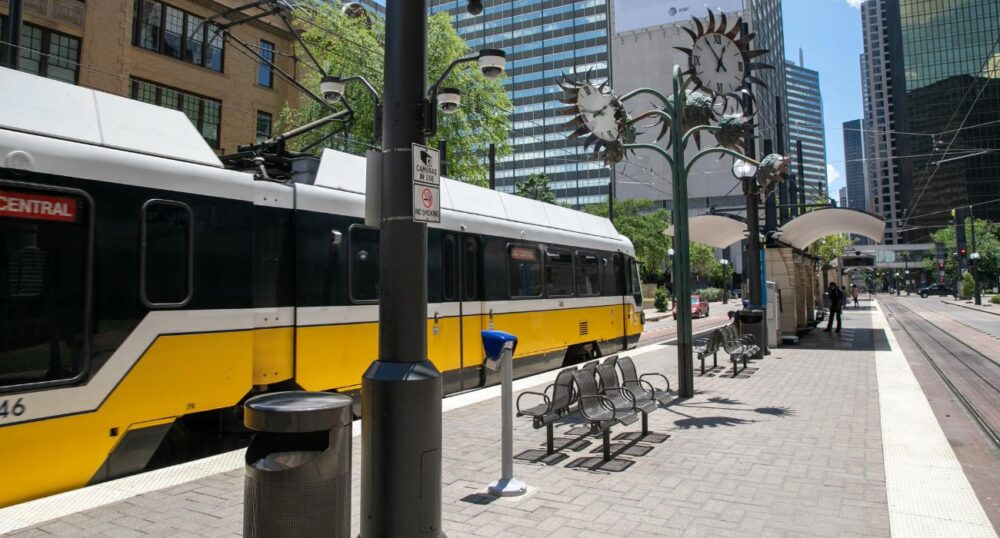In a joint meeting on Monday, DART president and CEO Nadine Lee briefed members of the agency’s board and the Transportation and Infrastructure Committee on security, ridership trends, and other issues impacting DART’s service area.
“We’ve been working on our strategic plan for the last year,” she said. “Some of the key points that drive our work here are the fact that we have 4 million people coming to the region over the next 20 years. The Dallas-Fort Worth region is expected to surpass Chicago as the third largest metro … in the next decade.”
The Dallas Area Rapid Transit, or DART, service area also includes Addison, Carrollton, Garland, Cockrell Hill, Farmers Branch, Glenn Heights, Irving, Richardson, Rowlett, Plano, Highland Park, Plano, and University Park — member cities that pay a 1-cent sales tax. Such revenue accounts for about 75% of DART’s roughly $1 billion budget, Lee said.
Through the implementation of six “strategic goals,” DART is targeting operational areas customers say need attention.
DART is spending “$110 million to provide rider improvements in the area of security, cleanliness, and reliability,” Lee said. “We have added 100 additional security officers to our system. And we have launched a DART Cares pilot program” that provides mental-health resources to passengers and others.
The Dallas Express reported in September that the initiative would cost taxpayers $1.6 million. Vagrancy and drug use have been widespread on DART trains, with some riders claiming other passengers have openly used what appeared to be heroin. In addition to the DART Cares program, which is a collaborative effort between Dallas Fire-Rescue, DART Police, and Parkland Hospital, the transit service is rolling out other initiatives to enhance security.
“DART is developing a multi-faceted security strategy that will incorporate a range of tools and resources to deliver peace of mind for all when interacting with DART,” according to an agency document.
That includes using an updated CCTV system and environmental designs to prevent crime, installing brighter LED lighting, and adding barriers and fencing.
DART also “modified the armed security guard services contract to provide 24-hour coverage at all bus and rail operating facilities” and added 100 uniformed armed security officers on trains, buses, and platforms in October.
“We look at hot spots in our system and try to make sure we provide security detail where it’s most appropriate,” Lee said. “Our response-time goal is 8 minutes. We are hitting 5 minutes.”
After some committee members, including Jaynie Schultz, Dallas City Council member for District 11, questioned Lee about sanitation concerns on DART trains and buses, the CEO said cleanliness is a priority for DART.
“We have inspectors going through and doing audit checks to make sure the cleaning teams are doing what they said they’re going to do,” Lee said. “It depends on the condition of the asset and the equipment. It depends on what the incident is, actually.”
DART provides daily cleanings at terminal stations, and buses are cleaned daily. Nearly 7,000 bus stops and shelters also receive at least weekly cleanings, and attendants are assigned to elevators to ensure people aren’t sleeping or living in them.
Meanwhile, DART is performing well on its route service, Lee said.
“The good news is that we are delivering on over 99% of scheduled trips, and this is no small feat. When I first started, we were only delivering on 85% of our scheduled trips.”
DART data suggests that:
- Bus and rail delivery is at 99%, up from 85% during the height of operator shortages in 2022.
- Bus service is “trending slightly lower” for on-time performance at 76% to 78%. The targeted percentage for bus service is 83%, and for rail service, 93%. Rail service is operating at close to the target range.
- As of April 3, 91.5% of budgeted full-time positions were filled.
- The number of budgeted positions is 3,851, including 1,241 for bus operators and 226 for rail operators.
- Ridership across the DART network is at 83% of pre-pandemic levels.
“Historically, the highest ridership point DART had was in 2019, right before the pandemic,” said Rob Smith, DART’s vice president of service planning and scheduling. “We have rolled out the first seven frequent service routes. Ridership was going up, and, of course, six or seven months later, it all collapsed. The 2006-2008 periods were nearly as busy when gas prices were spiking, and we had overloads on a lot of buses at that point.”
In February, the North Central Texas Council of Governments contracted two companies to develop a “next-generation” transit system for the region, The Dallas Express reported. It’s expected to:
- Develop strategies for infill development.
- Review fare-collection strategies.
- Develop recommendations for the transit authority-member city paradox.
- Develop a transit legislative program.
- Develop strategies to increase transit authority membership.
- Develop collaborations between existing transit authorities.
- Develop strategies for authority board partnerships and teamwork.
The metro area population is projected to increase to more than 11 million by 2045, with much of that growth expected outside existing transit authority service areas, according to the North Central Texas Council of Governments.

